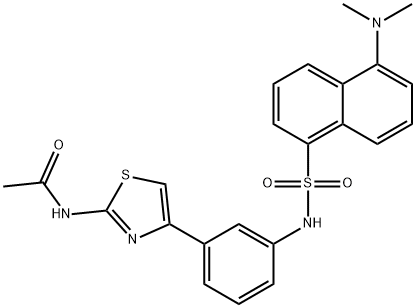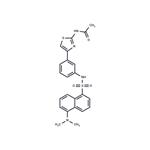Definition
ChEBI: HA15 is a sulfonamide resulting from the formal condensation of the sulfonic acid group of 5-(dimethylamino)naphthalene-1-sulfonic acid with the aniline nitrogen of 3-(2-acetamido-1,3-thiazol-4-yl)aniline. It has been reported that by triggering an endoplasmic reticulum (ER) stress response, HA15 can reduce the viability of melanoma cells without being toxic to normal cells. It has a role as an antineoplastic agent. It is a sulfonamide, a member of 1,3-thiazoles, a member of acetamides, a tertiary amino compound, an aminonaphthalene and a biaryl.
Biological Activity
HA15 is a small molecule that specifically targets HSPA5 (Heat shock 70kDa protein 5), also known as BiP (Immunoglobulin heavy-chain-binding protein) or Grp78 (glucose-regulated protein 78). Antitumor activity in melanoma cells tested, including cells isolated from patients and cells resistant to BRAF inhibitors.
in vitro
HA15 induces endoplasmic reticulum stress in cells in vitro, leading to cancer cell death; in melanoma cells, it overcomes its resistance to BRAF inhibitors.
in vivo
In xenograft mouse models (bearing melanoma cells sensitive or resistant to BRAF inhibitors), HA15 was able to induce endoplasmic reticulum stress leading to cancer cell death.
target
| Target | Value |
BiP/GRP78/HSPA5
() |

